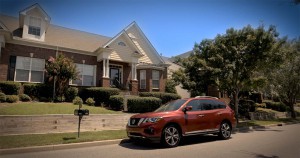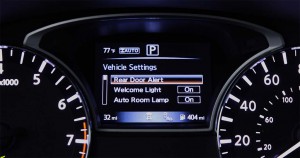Just days after a bill was introduced in Congress in an effort to prevent the death of children left in overheated vehicles, Nissan has introduced a new system aimed at addressing the problem.
The Rear Door Alert system will make its debut on the 2018 Nissan Pathfinder SUV when it goes on sale next month and will roll out on other models, the Japanese automaker said Wednesday, “in the coming years.” Nissan becomes the second automaker to offer a system intended to advise caregivers to make sure they haven’t inadvertently left a child in their vehicle, General Motors now offering its own system on a number of different models.
“If you open a rear door, whether to put a child or a package in the rear seat, the vehicle will help alert you when you reach your destination that you may want to check the rear seat,” explained Marlene Mendoza, a Nissan engineer and mother of three who helped develop the Rear Door Alert.
So far this year, 29 children have died in the U.S. after being left behind in hot vehicles. That includes two weekend fatalities in Phoenix. On average, 37 youngsters are killed due to heatstroke after being left in vehicles, a figure that rose to 39 last year and peaked at 49 in 2010, according to non-profit group NoHeatstroke.com.
In some cases, authorities say that children are intentionally left to die in vehicles. That includes toddler Cooper Harris, whose father Justin Ross Harris was convicted of murder last December by a Georgia jury. Tennessee parents Jade Elizabeth and Anthony Phillips were charged with murder last week after leaving their two-year-old in a hot car overnight.
While such intentional incidents might be difficult to prevent, experts contend the vast majority of child heatstroke deaths involving a vehicle are accidental possibly because the normal daily routine is disrupted. A mother may be sick, for example, requiring the father to drop the child off at daycare. Rushing to get to work, the parent may operate on autopilot and not remember having a child in the back seat for hours. On a hot day, that could prove too late.
“It can take mere minutes on a hot day for a car to turn into a deathtrap for a small child,” said Sen. Richard Blumenthal, a Connecticut Democrat and co-sponsor of the HOT CARS bill, more formally known as Senate Bill S.1666, the Helping Overcome Trauma for Children Alone in Rear Seats Act.
(For more on the Hot Car bill, Click Here.)
Over the past years, automakers have attempted to come up with high-tech solutions, GM aiming to develop a system that could detect the heartbeat of a child left in a vehicle. But such approaches proved unreliable.
The Nissan Rear Door Alert simply monitors whether the back door of a vehicle has been opened prior to a trip, perhaps to put a child in a car seat or simply to load up groceries. If that happened the Pathfinder’s alert system will watch to make sure the rear door is again opened when the vehicle reaches its destination. If not, it will trigger a series of escalating alerts, starting with a warning on the instrument panel and, ultimately, the sounding of a series of chirps on the SUV’s horn. The chirping horn is already used by Nissan to advise motorists when they put air into their tires that they’ve reached proper inflation.
(Save your child. Look back to see if a youngster has been left behind. For more tips, Click Here.)
 The GM system, offered by such brands as Chevrolet and Buick, also flashes a dashboard warning and then sounds a chime inside the vehicle. Nissan says it wants to catch caregivers who may already have exited their vehicle. Meanwhile, the automaker says a driver can turn off the system temporarily or permanently, perhaps someone who has no children but who often begins the day by tossing a gym back in the back of the vehicle.
The GM system, offered by such brands as Chevrolet and Buick, also flashes a dashboard warning and then sounds a chime inside the vehicle. Nissan says it wants to catch caregivers who may already have exited their vehicle. Meanwhile, the automaker says a driver can turn off the system temporarily or permanently, perhaps someone who has no children but who often begins the day by tossing a gym back in the back of the vehicle.
When the system is active and sounds the alarm, said Mendoza, “We want (you) to think for a moment about what you may have put in the back seat.”
(GM expands availability of life-saving technology. To see how it works, Click Here.)



A good step in the right direction but it should be mandatory for every vehicle and not to be disabled regardless of having children or not. What happens when grandma or grandpa has the baby? But this needs more steps,
1) the key fob must be able to vibrate or have its own built in alert,
2) a bluetooth connection from the vehicle to the drivers cell phone should remain connected for a few minutes after the ignition is turned off to send an alert, and
3) when all else fails a text message to be sent that has been in queue when the rear door was opened.
If I need to be reminded that a child is in my car, I should not be allowed to drive again until an exhaustive battery of cognitive function tests have been administered.